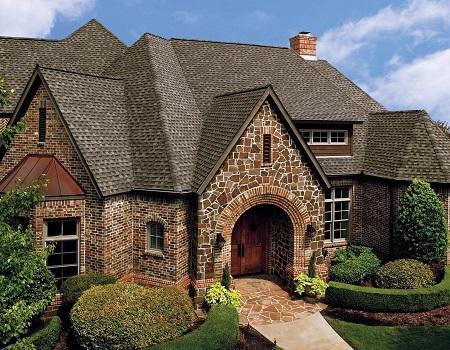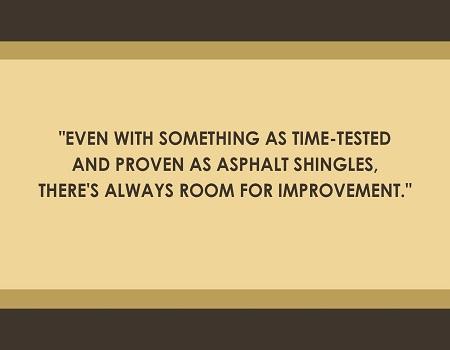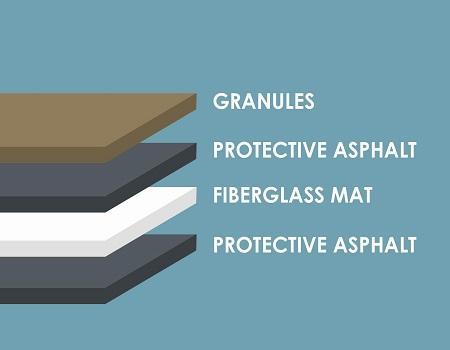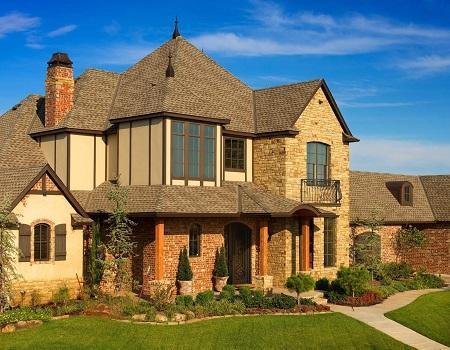You might have heard about how they’re making shingles out of fiberglass now. If you’re the kind of homeowner who likes to keep up on interesting trends in home improvement or, for that matter, are in the market for a new roof and are looking into your options, then you’ll definitely want to check out fiberglass shingles. Read on and discover exactly what all the buzz is about.
Where’s the glass?

TRADITIONAL LOOK: Fiberglass shingles look just like regular asphalt shingles
If you’ve looked at a picture of a fiberglass shingle then you might be wondering what the difference is; after all, they look pretty much the same as regular asphalt shingles. The thing is, the name is something of a misnomer. Fiberglass shingles aren’t made of fiberglass or, rather, not entirely out of fiberglass. Rather, they’re still regular asphalt roofing shingles in the main, but impregnated with fiberglass for added durability and resistance.
Traditionally, the base or “mat” of the shingle was made from a wood-and-paper felt material. This has, undoubtedly, worked well for years – asphalt shingles remain the most popular choice of roofing material in the United States – but even with something as time-tested and proven as asphalt shingles, there’s always room for improvement.
Why use fiberglass?

Fiberglass as a construction material is known for being a tough and very resilient substance. It does not change shape, and does not dry out. This sort of durability and reliability has been shown to work well with regular shingles, complementing and improving on an already-existing dependable design.
While on the outside a fiberglass shingle is still the same old asphalt roofing shingle you’re no doubt familiar with, the inside is where the real difference in construction can be seen. The particular fiberglass used in the mat of the shingle is compiled from layers of wet fiberglass bonded together with a urea-formaldehyde resin. This layer of plastic, reinforced with fine glass fibers, is the source of the fiberglass shingle’s strength and durability.
The asphalt used in fiberglass shingles is not your normal everyday asphalt, either. Instead, the asphalt is mixed during production with various mineral fillers. This helps impart improved waterproofing to both the mat and the shingle in general.
What do we have here?

LAYERS MATTER: The many layers of a fiberglass shingle
The resultant mix of asphalt and fiberglass has shown itself to be superior in every way to regular asphalt. Backed by fiberglass’ native durability, fiberglass shingles are more durable. How so? They are better at resisting impact – such as the sort you’d get during a hail storm – and also at holding up much better under the effects of exposure to high winds, freezing temperatures, and the potential damage that can happen when you or other people walk on your roof.
Because fiberglass is stronger, structurally, than felt, there’s also less need for so much material for the shingle’s mat. This has resulted in a thinner, lighter shingle that is nevertheless stronger and more durable than the more “organic” shingles are. With less weight on your roof’s supports, you’re less likely to experience problems that might be caused by the weight of the roof. In the rare cases where you’re shingling over an older existing roof instead of tearing the old one off first before installing a new one, this can make a tremendous difference, especially if you’re not certain whether or not your home’s structure can support the roof.
In addition to its other properties, fiberglass is also way more resistant to fire and the effects of heat than asphalt is. Where normal asphalt shingles have been known to melt or catch fire themselves in the event of a fire in the house below – greatly contributing to the danger of an already bad situation – fiberglass shingles are a lot less likely to do so. It’s not just when your house is on fire that fiberglass’ fire resistance makes a difference, however. Even on a hot, unventilated roof, fiberglass shingles are not as prone to curling and warping the way regular asphalt shingles would be. This can make all the difference in a hot, sunny environment.
What’s in it for me?

SHINGLES GOT THE LOOK: A beautiful home, shingled with fiberglass
Aside from the obvious and rather stark differences between your old or current asphalt roof and one that’s been shingled with fiberglass, there are clear financial benefits to installing a fiberglass roof. You might not be in the market for a replacement roof now, but you might very well find yourself looking for available roofing options sometime down the road. Hot, humid summers and freezing, stormy winters can take a toll on roofs, after all.
First off, fiberglass shingles aren’t all that much more expensive than regular asphalt shingles. While there is something of a rise in price, due to the added fiberglass fiber filler, the difference in price is nowhere near that of asphalt and wood, or even asphalt and the next more expensive roof material in price, typically metal. You might be paying a little bit more than you would for regular “organic” asphalt shingles, but not appreciably more.
Secondly, fiberglass shingles also last a lot longer than regular shingles do. This means that over time you’ll be spending less on roof repair and replacement than you would with the more traditional asphalt-only shingles. Less breakage and a longer lifespan also mean less in the way of having to interrupt your existing schedule to have repairs done on your damaged roof.
That also translates into better, longer warranty coverage than your typical asphalt shingle. Some companies are willing to provide up to 50 years of warranty coverage on their fiberglass shingles, as compared to the more typical coverage of 20 years for regular asphalt shingles. With that kind of a guarantee, you end up spending less money and having to endure fewer headaches – all with a small, but significant, difference in your choice of roofing material.
============================================================
Author Bio:
Taking up the reins of Howard Roofing & Home Improvements after the retirement of his father, Gary Howard brings 16 years of experience in the roofing industry to his position as president. In addition to expanding the company to new levels of marketing, Gary has managed to maintain the standard of ethics set by his father, continuing their commitment to the community.
============================================================
